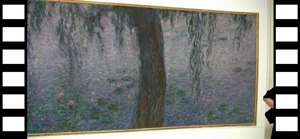The Musée de l'Orangerie is located in
the southwest corner of the Jardin des Tuileries, the largest public park in Paris.
The garden is situated between the Place de la Concorde and the Louvre, and dates
back to the 16th Century, when it was first set aside by Catherine de Medicis, the
widow of Henry II, as the garden to accompany the new Tuileries Palace. Since that
time it has undergone periods of expansion, remodeling and neglect. The palace
to which it was attached was burned down in 1871, but the garden remains as a
public park.
Nella and Tuileries
The Orangerie was a relatively recent addition, having been built in 1852,
when there was still a Palais des Tuileries, by Louis Napoleon as an orangery.
An orangery is a sort of greenhouse used to store sensitive plants
(such as citrus trees) during cold winter months. In the early 20th Century
the artist Claude Monet was on a binge during which he was painting large
numbers of paintings of the water lilies in his garden at Giverny (he
eventually painted 250 of them, a series known as the Nymphéas), and he
wanted to donate some large murals of them to the French people. Work began on
the existing Orangerie building as a place to exhibit them, and the murals
went on display in 1927, shortly after Monet's death in December of 1926.
There are currently eight murals, on display in two oval rooms which are lit
by filtered sunlight.

Water Lilies, Morning, Claude Monet (1914-18)

Water Lilies at Sunset, Claude Monet (1915-26)

Bright Morning with Willow Trees, Claude Monet (1914-18)

Bob in Monet Room
Bright Morning with Willow Trees, Claude Monet (1914-18)
In 1965 the museum's collection was significantly expanded through the acquisition
of a collection built by the collectors Paul Guillaume and Jean Walter, the
collection being donated by their widow (to whom they were married at different
times), named Domenica (suspected by some to be involved in the suspicious deaths
of both husbands), after her own death. This collection consists of several
impressionist and post-impressionist paintings, as well as many 20th-Century
paintings which probably wouldn't fit into either category (some look like
products of bad dreams but are fascinating). The collection (and more) are found
downstairs in the museum. Also downstairs is a reconstruction of the apartment of
Paul Guillaume, with the walls covered by amazing paintings.

Nude Amid Landscape, Pierre-Auguste Renoir (1883)

Portrait of Two Young Girls, Pierre-Auguste Renoir (1890-92)

Argenteuil, Claude Monet (1875)

Portrait of Madame Cézanne, Paul Cézanne (1890)
Child with Doll, Henri Rousseau (1904-05)

Landscape, Paul Gauguin (1901)

Landscape with Red Rooftop, Paul Cézanne (1875-76)

Paul Guillaume, Novo Pilota, Amedeo Modigliani (1915)

Odalisque in Red Pants, Henri Matisse (1924-25)

Woman with Sofa, Henri Matisse (1921)

Reclining Nude with Drapery, Henri Matisse (1923-24)

Harlequin and Pierrot, André Derain (1924)

Woman with Tamborine, Pablo Picasso (1925)

Large Nude with Drapery, Pablo Picasso (1920-21)

La Butte Pinson, Maurice Utrillo (1905-07)

Houses, Chaïm Soutine (1920-21)

Rue du Mont-Cenis, Maurice Utrillo (1914)

The Best Man, Chaïm Soutine (1924-25)

The Fiancée, Chaïm Soutine (1923)
After visiting the Orangerie (included in the Museum Pass, by the way), we walked
across the garden, looking for a place to get lunch. There were a couple of cafés
in the park, but they were expensive, so we kept going. We did see several sculptures
on display in the park, as well as large ponds used by children (like the pond at the
Luxembourg gardens) to launch toy sailboats.

Reclining Figure, Henry Moore (1951)

Standing Figure, Willem de Kooning (1969-84)
In the northeast corner of the park we found a small carnival, with a few rides
(including a large ferris wheel) and stalls selling not-very-nutritious snacks.

Jardin des Tuileries and Louvre with Ferris Wheel

Candy for Sale
We continued out of the park and crossed the Rue de Rivoli (laid out and
named by Napoleon after one of his victories) to the north. On the other
side of the street were several arcaded business establishments, among
which we eventually found a reasonably-priced cafeteria. After refueling
we found a Metro station and hopped a train to our next stop, the
Pompidou Center.





























